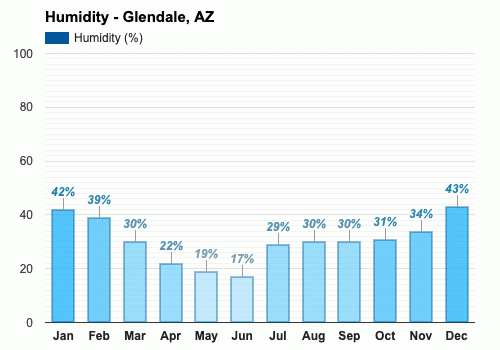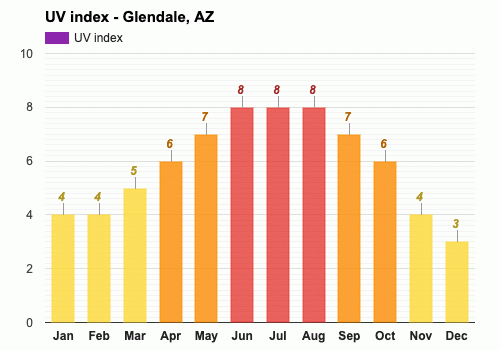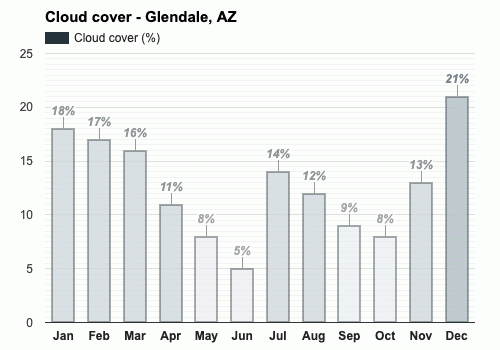Contents
- The climate of Glendale
- The Best Time to Visit Glendale
- The Worst Time to Visit Glendale
- Spring Weather in Glendale
- Summer Weather in Glendale
- Autumn Weather in Glendale
- Winter Weather in Glendale
- Weather in January
- Weather in February
- Weather in March
- Weather in April
- Weather in May
- Weather in June
- Weather in July
- Weather in August
- Weather in September
- Weather in October
- Weather in November
- Weather in December
- Frequently asked questions
- Average temperature
- Average pressure
- Average wind speed
- Average humidity
- Average rainfall
- Average rainfall days
- Average daylight
- Average sunshine
- Average sunshine days
- Average UV index
- Average cloud cover
- Average visibility

Climate and monthly weather forecast
The climate of Glendale
The city's temperature chart shows an expected increase from 63.7°F (17.6°C) in January, peaking at 101.8°F (38.8°C) in July, decreasing thereafter to reach 61.9°F (16.6°C) by December. A substantial variation between daytime high and night-time low can be perceived, ranging from 46.9°F (8.3°C) to 82.8°F (28.2°C). The least amount of temperature disparity occurs in July and August, where the spread narrows to between 82.8°F (28.2°C) and 101.8°F (38.8°C). Glendale receives fresh winds all through the year with a mild steadiness varying from 4.6mph (7.4km/h) to 6.6mph (10.6km/h).
An interesting aspect of Glendale's climate is the low humidity that hovers between 17% to 43%. The least humid month is June, while the most humid one is December. Notably, rainfall is sparse across most of the year, with only 0.08 in falling in June, which increases to 1.18 in during August, and again drops to 0.75 in by December. It seems that the city can count on extended hourly sunlight, with daylight extending from 10 hours to a high of 14.4 hours in June.
The Best Time to Visit Glendale
The Worst Time to Visit Glendale
Spring Weather in Glendale
Summer Weather in Glendale
Autumn Weather in Glendale
Winter Weather in Glendale
Weather in January
Weather in February
Weather in March
Weather in April
Weather in May
Weather in June
Weather in July
Weather in August
Weather in September
Weather in October
Weather in November
Weather in December
Published by: Weather U.S. | About Us
Data Sources | Weather Forecasting & Climate
Frequently asked questions
How much does it rain in Glendale?
What is the least humid month in Glendale?
What is the driest month in Glendale?
When are the longest days in Glendale?
What month has the most sunshine in Glendale?
When is the highest UV index in Glendale?
What is the warmest month in Glendale?
What is the rainiest month in Glendale?
What is the coldest time of year in Glendale?
What is the most humid month in Glendale?
What is the month with the shortest days in Glendale?
Is there Daylight Saving Time (DST) in Glendale?
What is the month with the least sunshine in Glendale?
When is the lowest UV index in Glendale?

Average temperature
Glendale, AZ
The warmest month (with the highest average high temperature) is July (101.8°F).
The month with the lowest average high temperature is December (61.9°F).
The month with the highest average low temperature is August (83.7°F).
The coldest month (with the lowest average low temperature) is December (46.8°F).

Average pressure
Glendale, AZ
- Average pressure in January:
30.09"Hg - Average pressure in February:
30.02"Hg - Average pressure in March:
29.96"Hg - Average pressure in April:
29.88"Hg - Average pressure in May:
29.84"Hg - Average pressure in June:
29.8"Hg
- Average pressure in July:
29.86"Hg - Average pressure in August:
29.86"Hg - Average pressure in September:
29.86"Hg - Average pressure in October:
29.91"Hg - Average pressure in November:
30.01"Hg - Average pressure in December:
30.06"Hg
The month with the highest atmospheric pressure is January (30.09"Hg).
The month with the lowest atmospheric pressure is June (29.8"Hg).

Average wind speed
Glendale, AZ
- Average wind speed in January:
4.8mph - Average wind speed in February:
5mph - Average wind speed in March:
5.7mph - Average wind speed in April:
6.6mph - Average wind speed in May:
6.6mph - Average wind speed in June:
6.1mph
- Average wind speed in July:
6.1mph - Average wind speed in August:
5.4mph - Average wind speed in September:
5.3mph - Average wind speed in October:
5mph - Average wind speed in November:
4.8mph - Average wind speed in December:
4.6mph
The windiest months (with the highest average wind speed) are April and May (6.6mph).
The calmest month (with the lowest average wind speed) is December (4.6mph).

Average humidity
Glendale, AZ
The month with the highest relative humidity is December (43%).
The month with the lowest relative humidity is June (17%).

Average rainfall
Glendale, AZ
- Average rainfall in January:
0.67" - Average rainfall in February:
0.79" - Average rainfall in March:
0.75" - Average rainfall in April:
0.16" - Average rainfall in May:
0.12" - Average rainfall in June:
0.08"
- Average rainfall in July:
1.14" - Average rainfall in August:
1.18" - Average rainfall in September:
1.1" - Average rainfall in October:
0.87" - Average rainfall in November:
0.63" - Average rainfall in December:
0.75"
The wettest month (with the highest rainfall) is August (1.18").
The driest month (with the least rainfall) is June (0.08").

Average rainfall days
Glendale, AZ
- Average rainfall days in January:
4 days - Average rainfall days in February:
4.3 days - Average rainfall days in March:
4 days - Average rainfall days in April:
3.2 days - Average rainfall days in May:
2.3 days - Average rainfall days in June:
1.1 days
- Average rainfall days in July:
10.7 days - Average rainfall days in August:
10.1 days - Average rainfall days in September:
6.7 days - Average rainfall days in October:
4 days - Average rainfall days in November:
3.3 days - Average rainfall days in December:
6 days
The month with the highest number of rainy days is July (10.7 days).
The month with the least rainy days is June (1.1 days).

Average daylight / Average sunshine
Glendale, AZ
- Average daylight in January:
10h and 1min - Average daylight in February:
11h and 0min - Average daylight in March:
12h and 0min - Average daylight in April:
13h and 0min - Average daylight in May:
13h and 5min - Average daylight in June:
14h and 2min
- Average daylight in July:
14h and 1min - Average daylight in August:
13h and 2min - Average daylight in September:
12h and 2min - Average daylight in October:
11h and 2min - Average daylight in November:
10h and 2min - Average daylight in December:
10h and 0min
The month with the longest days is June (Average daylight: 14h and 18min).
The month with the shortest days is December (Average daylight: 10h and 0min).
- Average sunshine in January:
7h and 1min - Average sunshine in February:
9h and 1min - Average sunshine in March:
9h and 1min - Average sunshine in April:
10h and 5min - Average sunshine in May:
11h and 5min - Average sunshine in June:
12h and 1min
- Average sunshine in July:
12h and 0min - Average sunshine in August:
11h and 5min - Average sunshine in September:
9h and 4min - Average sunshine in October:
8h and 1min - Average sunshine in November:
7h and 2min - Average sunshine in December:
6h and 5min
The month with the most sunshine is June (Average sunshine: 12h and 12min).
The month with the least sunshine is December (Average sunshine: 6h and 48min).

Average sunshine days
Glendale, AZ
- Average sunshine days in January:
26.3 days - Average sunshine days in February:
23.3 days - Average sunshine days in March:
27.2 days - Average sunshine days in April:
27.3 days - Average sunshine days in May:
28.6 days - Average sunshine days in June:
27.8 days
- Average sunshine days in July:
16.4 days - Average sunshine days in August:
15.9 days - Average sunshine days in September:
20.5 days - Average sunshine days in October:
25.8 days - Average sunshine days in November:
26.5 days - Average sunshine days in December:
24.3 days
The month with the most sunshine days is May (28.6 days).
The month with the least sunshine days is August (15.9 days).

Average UV index
Glendale, AZ
The months with the highest UV index are June, July and August (UV index 8).
The month with the lowest UV index is December (UV index 3).

Average cloud cover
Glendale, AZ
The month with the most cloud cover is December (Cloud cover 21).
The month with the least cloud cover is June (Cloud cover 5).

Average visibility
Glendale, AZ
The months with the highest visibility are January, February, March, April, May, June, July, August, September, October, November and December (6mi).
The months with the lowest visibility are January, February, March, April, May, June, July, August, September, October, November and December (6mi).